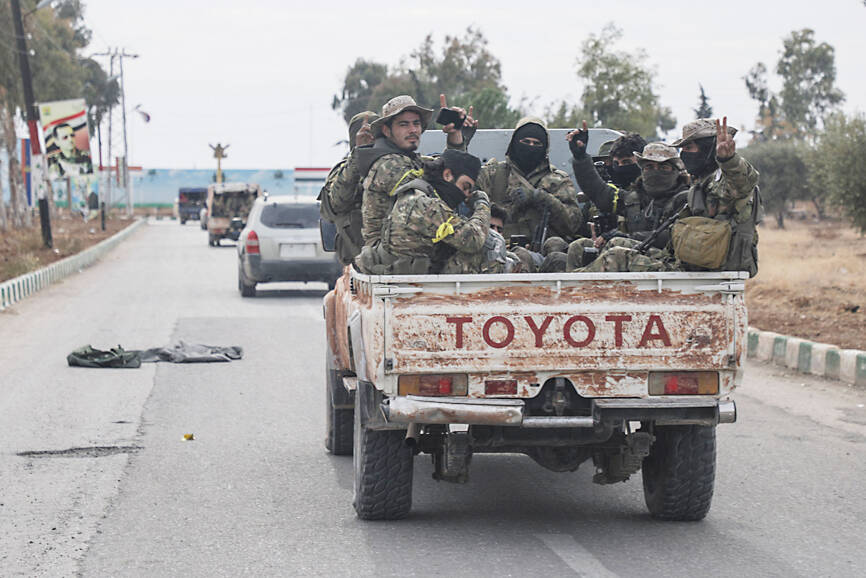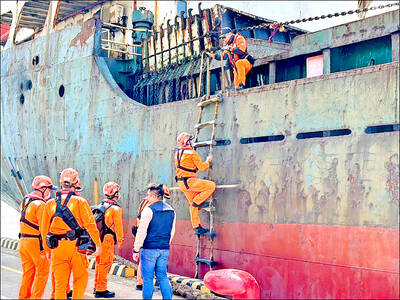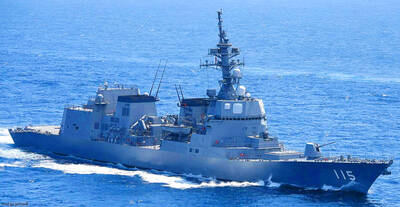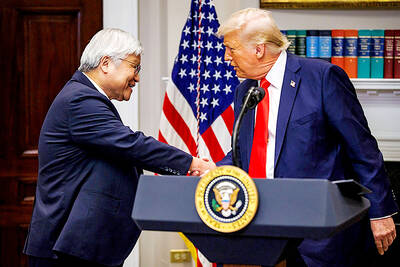The Syrian army withdrew from much of southern Syria yesterday, leaving more areas of the country, including two provincial capitals, under the control of opposition fighters, the military and an opposition war monitor said.
The redeployment away from the provinces of Daraa and Sweida came as Syria’s military sent large numbers of reinforcements to defend the key central city of Homs, Syria’s third largest, as insurgents approached its outskirts.
The rapid advances by insurgents are a stunning reversal of fortunes for Syrian President Bashar al-Assad, who appears to be largely on his own, with erstwhile allies preoccupied with other conflicts.

Photo: Reuters
His chief international backer, Russia, is busy with its war in Ukraine, and Lebanon’s powerful Hezbollah, which at one point sent thousands of fighters to shore up his forces, has been weakened by a yearlong conflict with Israel.
Meanwhile, Iran has seen its proxies across the region degraded by regular Israeli airstrikes.
Rami Abdurrahman, who heads the Syrian Observatory for Human Rights, a Syria war monitor, reported yesterday that Iran’s military advisers have started leaving Syria, adding that Iran-backed fighters in eastern Syria, mainly from Afghanistan and Pakistan, have withdrawn into central Syria.
The shock offensive began on Nov. 27 led by Hayat Tahrir al-Sham (HTS), during which gunmen captured the northern city of Aleppo, Syria’s largest, and the central city of Hama, the country’s fourth largest city.
HTS leader Abu Mohammed al-Jolani told CNN in an exclusive interview on Thursday that the aim of the offensive is to overthrow al-Assad’s government.
If the insurgents capture Homs, they would cut the link between Damascus, al-Assad’s seat of power, and the coastal region where the president has wide support.
A source speaking on condition of anonymity yesterday said Hezbollah has sent 2,000 fighters into Syria near the border “to defend its positions there,” but it “has not yet participated in any battles” with Syrian rebels.
After the fall of the cities of Daraa and Sweida early yesterday, Syrian government forces remain in control of five provincial capitals — Damascus, Homs and Quneitra, as well as Latakia and Tartus on the Mediterranean coast.
Tartus is home to the only Russian naval base outside the former Soviet Union while Latakia is home to a major Russian air base.
On Friday, US-backed fighters of the Kurdish-led Syrian Democratic Forces (SDF) captured wide parts of the eastern province of Deir el-Zour that borders Iraq and the provincial capital that carries the same name.
The capture of areas in Deir el-Zour is a blow to Iran’s influence in the region as the area is the gateway to the corridor linking the Mediterranean to Iran, a supply line for Iran-backed fighters, including Lebanon’s Hezbollah.
With the capture of a main border crossing with Iraq by the SDF and after opposition fighters took control of the Naseeb border crossing to Jordan in southern Syria, the Syrian government’s only gateway to the outside world is the Masnaa border crossing with Lebanon.
See can on page 5

A Chinese freighter that allegedly snapped an undersea cable linking Taiwan proper to Penghu County is suspected of being owned by a Chinese state-run company and had docked at the ports of Kaohsiung and Keelung for three months using different names. On Tuesday last week, the Togo-flagged freighter Hong Tai 58 (宏泰58號) and its Chinese crew were detained after the Taipei-Penghu No. 3 submarine cable was severed. When the Coast Guard Administration (CGA) first attempted to detain the ship on grounds of possible sabotage, its crew said the ship’s name was Hong Tai 168, although the Automatic Identification System (AIS)

An Akizuki-class destroyer last month made the first-ever solo transit of a Japan Maritime Self-Defense Force ship through the Taiwan Strait, Japanese government officials with knowledge of the matter said yesterday. The JS Akizuki carried out a north-to-south transit through the Taiwan Strait on Feb. 5 as it sailed to the South China Sea to participate in a joint exercise with US, Australian and Philippine forces that day. The Japanese destroyer JS Sazanami in September last year made the Japan Maritime Self-Defense Force’s first-ever transit through the Taiwan Strait, but it was joined by vessels from New Zealand and Australia,

SECURITY: The purpose for giving Hong Kong and Macau residents more lenient paths to permanent residency no longer applies due to China’s policies, a source said The government is considering removing an optional path to citizenship for residents from Hong Kong and Macau, and lengthening the terms for permanent residence eligibility, a source said yesterday. In a bid to prevent the Chinese Communist Party (CCP) from infiltrating Taiwan through immigration from Hong Kong and Macau, the government could amend immigration laws for residents of the territories who currently receive preferential treatment, an official familiar with the matter speaking on condition of anonymity said. The move was part of “national security-related legislative reform,” they added. Under the amendments, arrivals from the Chinese territories would have to reside in Taiwan for

CRITICAL MOVE: TSMC’s plan to invest another US$100 billion in US chipmaking would boost Taiwan’s competitive edge in the global market, the premier said The government would ensure that the most advanced chipmaking technology stays in Taiwan while assisting Taiwan Semiconductor Manufacturing Co (TSMC, 台積電) in investing overseas, the Presidential Office said yesterday. The statement follows a joint announcement by the world’s largest contract chipmaker and US President Donald Trump on Monday that TSMC would invest an additional US$100 billion over the next four years to expand its semiconductor manufacturing operations in the US, which would include construction of three new chip fabrication plants, two advanced packaging facilities, and a research and development center. The government knew about the deal in advance and would assist, Presidential